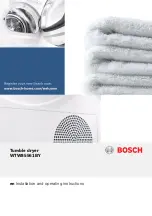
Installing and connecting the appliance
en
13
■
If you take hold of any of the
appliance's protruding parts (e.g. the
appliance door) in order to lift or
move it, these parts may break off
and cause injury.
Do not take hold of any of the
appliance's protruding parts in order
to move the appliance.
:
Warning
Risk of injury!
■
The appliance is very heavy. Lifting it
may result in injury.
Do not lift the appliance on your
own.
Risk of injury!
■
The appliance has sharp edges on
which you could cut your hands.
Do not take hold of the appliance by
its sharp edges. Wear protective
gloves to lift it.
Caution!
Material damage/damage to the
appliance
If the appliance overheats, it may not be
able to operate properly, or this may
result in material damage or damage to
the appliance.
Make sure that the appliance's air inlet
is never obstructed when the appliance
is in operation, and that the area around
the appliance is adequately ventilated.
Install the appliance as follows:
1.
Place the appliance on a clean,
even, solid surface.
2.
Check that the appliance is level
using a spirit level.
3.
If necessary, turn the appliance feet
to make sure it is level.
You can now connect the appliance.
Notes
■
All appliance feet must stand firmly
on the ground.
■
If appliances are not installed
correctly, this may result in noises,
vibrations, uneven drum operation
and/or to residual water leaking out
of the appliance.
Connecting the appliance
:
Warning
Risk of electric shock/fire/material
damage/damage to the appliance!
If the appliance is not installed properly,
this may lead to a dangerous situation.
Make sure that:
■
The mains voltage on your power
socket matches the rated voltage
specified on the appliance
(identification plate). The connected
loads and the required fuse
protection are specified on the
identification plate.
■
The appliance is only connected to a
source of alternating current via a
nationally recognized and grounded
outlet that has been correctly
installed.
■
The mains plug and the grounded
socket match and the earthing
system has been correctly installed.
■
The cross section of the cable is
sufficiently large enough.
■
The mains plug is accessible at all
times.
■
If using a residual current circuit
breaker, only use one that bears the
following mark:
z
. The presence of
this mark is the only way to be sure
that it fulfils all the applicable
regulations.














































